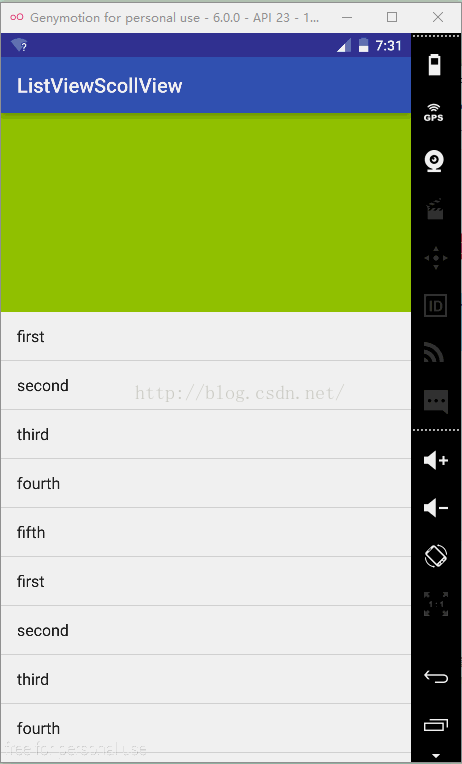onMeasure简单方法 完美解决ListView与ScollView冲突问题!
近期做项目碰到ScrollView与Listview冲突的情况,查看了网上一些解决listview和scollView的冲突的方法,最终选择了重写onMeasure的方法来解决这个问题。
在此对各种方法个人做一个总结评价。
主要的方法有四种:
1、手动设置ListView高度(比如把高度设置为200dp)
评价:特别简单无脑,但是大大提高了代码的耦合性,比较适合“图方便”的新手。
2、使用单个ListView的addHeaderView()方法(给listview设置顶部固定的一个view)
评价:比较简便的方法,但是如果顶部布局需要监听滑动事件,也不可取。
3、使用LinearLayout取代ListView(重写LinearLayout)
评价:完全可行,但是让一个LinearLayout来实现Listview的功能真的觉得好奇怪啊。
4、重写ListView的onMeasure()
评价:只需要写几行代码,轻松解决冲突问题。不仅降低代码耦合性,而且简单。唯一的缺点,可能就是理解需要花比较多的时间。
最终效果:(左图为改之前,右图为改之后,源码在文章结尾)
主要实现代码:
@Override
protected void onMeasure(int widthMeasureSpec, int heightMeasureSpec) {
int expandSpec = MeasureSpec.makeMeasureSpec(Integer.MAX_VALUE >> 2,
MeasureSpec.AT_MOST);
super.onMeasure(widthMeasureSpec, expandSpec);
}
如上所示,使用expandSpec代替heightMeasureSpec。很容易理解,就是我们改变了的listview的高度获取方式。
那么MeasureSpec.makeMeasureSpec(int size,int mode)中的两个参数又是什么呢?
size:表示父布局提供给你的大小参考
mode:表示规格,有EXACTLY、AT_MOST、UNSPECIFIED三种。
那么我们代码中填的两个值又分别表示什么呢?
Integer.MAX_VALUE >> 2:表示父布局给的参考的大小无限大。(listview无边界)
MeasureSpec.AT_MOST:表示根据布局的大小来确定listview最终的高度,也就是有多少内容就显示多高。
(此处三种方式解释引用郭霖前辈文章中部分内容)
1. EXACTLY
表示父视图希望子视图的大小应该是由specSize的值来决定的,系统默认会按照这个规则来设置子视图的大小,开发人员当然也可以按照自己的意愿设置成任意的大小。
2. AT_MOST
表示子视图最多只能是specSize中指定的大小,开发人员应该尽可能小得去设置这个视图,并且保证不会超过specSize。系统默认会按照这个规则来设置子视图的大小,开发人员当然也可以按照自己的意愿设置成任意的大小。
3. UNSPECIFIED
表示开发人员可以将视图按照自己的意愿设置成任意的大小,没有任何限制。这种情况比较少见,不太会用到。
倘若读者还有疑问或者对View的绘制过程比较感兴趣,可以参考郭霖前辈的博客:
Android视图绘制流程完全解析,带你一步步深入了解View(二)
http://blog.csdn.net/guolin_blog/article/details/16330267
MainActivity:
package com.example.double2.listviewscollview;
import android.support.v7.app.AppCompatActivity;
import android.os.Bundle;
import android.widget.ArrayAdapter;
public class MainActivity extends AppCompatActivity {
private MyListView mMyListView;
final private String[] test = {
"first", "second", "third", "fourth", "fifth",
"first", "second", "third", "fourth", "fifth"};
@Override
protected void onCreate(Bundle savedInstanceState) {
super.onCreate(savedInstanceState);
setContentView(R.layout.activity_main);
initListView();
}
private void initListView() {
mMyListView = (MyListView) findViewById(R.id.lv_main);
mMyListView.setAdapter(
new ArrayAdapter<String>(
this, android.R.layout.simple_list_item_1, test));
}
}
package com.example.double2.listviewscollview;
import android.content.Context;
import android.util.AttributeSet;
import android.widget.ListView;
/**
* 项目名称:ListViewScollView
* 创建人:Double2号
* 创建时间:2016/5/22 19:01
* 修改备注:
*/
public class MyListView extends ListView {
public MyListView(Context context) {
super(context);
}
public MyListView(Context context, AttributeSet attrs) {
super(context, attrs);
}
public MyListView(Context context, AttributeSet attrs, int defStyleAttr) {
super(context, attrs, defStyleAttr);
}
@Override
protected void onMeasure(int widthMeasureSpec, int heightMeasureSpec) {
//此处是代码的关键
//MeasureSpec.AT_MOST的意思就是wrap_content
//Integer.MAX_VALUE >> 2 是使用最大值的意思,也就表示的无边界模式
//Integer.MAX_VALUE >> 2 此处表示是福布局能够给他提供的大小
int expandSpec = MeasureSpec.makeMeasureSpec(Integer.MAX_VALUE >> 2,
MeasureSpec.AT_MOST);
super.onMeasure(widthMeasureSpec, expandSpec);
}
}
activity_main:
<?xml version="1.0" encoding="utf-8"?>
<ScrollView
xmlns:android="http://schemas.android.com/apk/res/android"
android:layout_width="match_parent"
android:layout_height="wrap_content">
<LinearLayout
android:layout_width="match_parent"
android:layout_height="wrap_content"
android:orientation="vertical"
>
<View
android:layout_width="match_parent"
android:layout_height="200dp"
android:background="@android:color/holo_green_light"
/>
<com.example.double2.listviewscollview.MyListView
android:id="@+id/lv_main"
android:layout_width="match_parent"
android:layout_height="match_parent"/>
</LinearLayout>
</ScrollView>
源码地址:http://download.csdn.net/detail/double2hao/9527896

